September 23, 2016
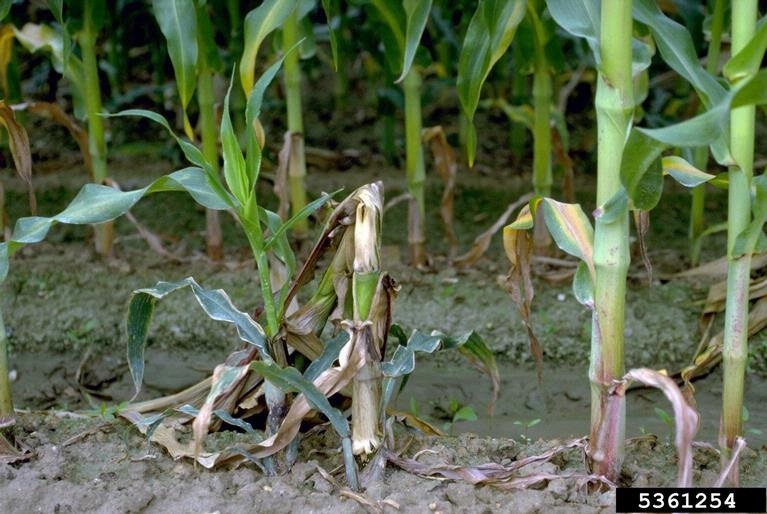
Top Dieback
A number of corn fields are showing top dieback symptoms. Top dieback is when two or more of the topmost corn leaves die prematurely. This can be caused by a number of factors including fungal infection, hybrid (senescence starts from the top leaves), and insect damage.
Usually fungal infection is the top culprit. While it is normal to see the top corn leaves dry due to natural senescence around this time of the season, premature death of top leaves before black layer can lead to yield loss.
Scouting & Management
Determining whether the top dieback is due to natural senescence or disease can be done by looking at the distribution of affected plants in the field. If all of the plants in the field have the 2-3 top leaves dying, this may be due to natural senescence.
However, if random plants in the field have the top leaves dying, this may be due to anthracnose top dieback disease caused by the fungal pathogen, Colletotricum graminicola. Plants infected with anthracnose top dieback have black spots on the stalk that can be seen when the leaf sheath is peeled away (Figure 2). A closer look at the black spots with a hand lens may reveal the survival structures of the fungus.
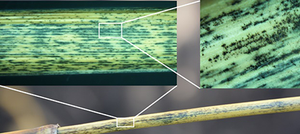
Anthracnose top dieback can be managed through selection of resistant hybrids. Fungicides applied at flowering may help in reducing top dieback. Tillage to bury residue will also reduce the pathogen inoculum.
Stalk Rots
Another set of corn diseases being seen at this time are the stalk rots.
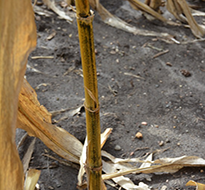
Corn stalk rots are caused by several pathogens but the most common stalk rots are caused by Colletotricum graminocola (anthracnose stalk rot), Fusarium spp. and Gibberella zea. Stalks with anthracnose stalk rot have black spots on the lower nodes (Figure 3).
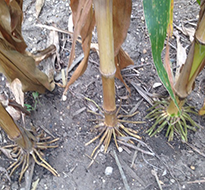 Fusarium stalk rot is not easy to diagnose but usually the plant dies prematurely and may not have black spots (Figure 4). For Gibberella stalk rot, splitting the stem may reveal pinkish discoloration of the pith.
Fusarium stalk rot is not easy to diagnose but usually the plant dies prematurely and may not have black spots (Figure 4). For Gibberella stalk rot, splitting the stem may reveal pinkish discoloration of the pith.
Scouting & management
Nothing can be done about the stalk rots developing in corn at this time, but management decisions can be made for the next growing season. Scouting corn fields at this time to determine which fields have high stalk rot incidence can inform producers which fields may need early harvesting before heavy lodging can occur.
Scouting for stalk rots can be done using the push method on 10 corn stalks at a minimum of five random stops within a field. The push method is accomplished by gently pushing the corn stalk to about 45° away from the upright position.
Stalks with rots will crumple at the first or second node above the soil or may fail to right themselves (Figure 5). Fields with 10% or more incidence of stalk rot should be scheduled for early harvesting. While this may incur an added expense of drying grain, it will facilitate clean combining as opposed to combining lodged corn.
Stalk rots are best managed through careful selection of resistant/tolerant corn hybrids. Seed companies provide ratings of stalk rot scores or stalk strength. For fields with a history of stalk rot, select corn hybrids with high ratings. 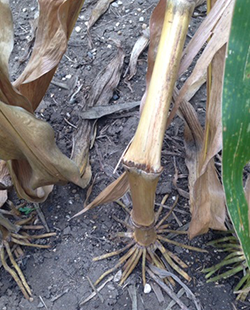
Cultural practices like a good fertility program, proper plant populations, and other practices that reduce plant stress can lessen the chances of stalk rot development.
Originally posted by South Dakota State University Extension.
You May Also Like




